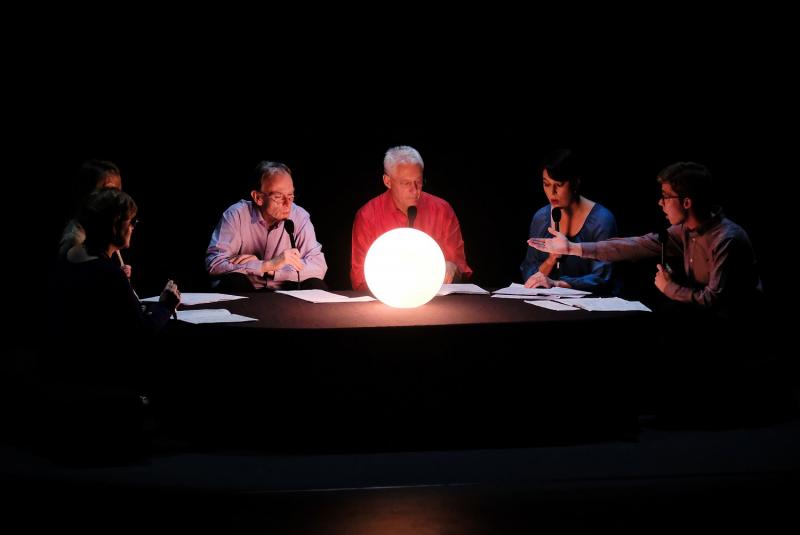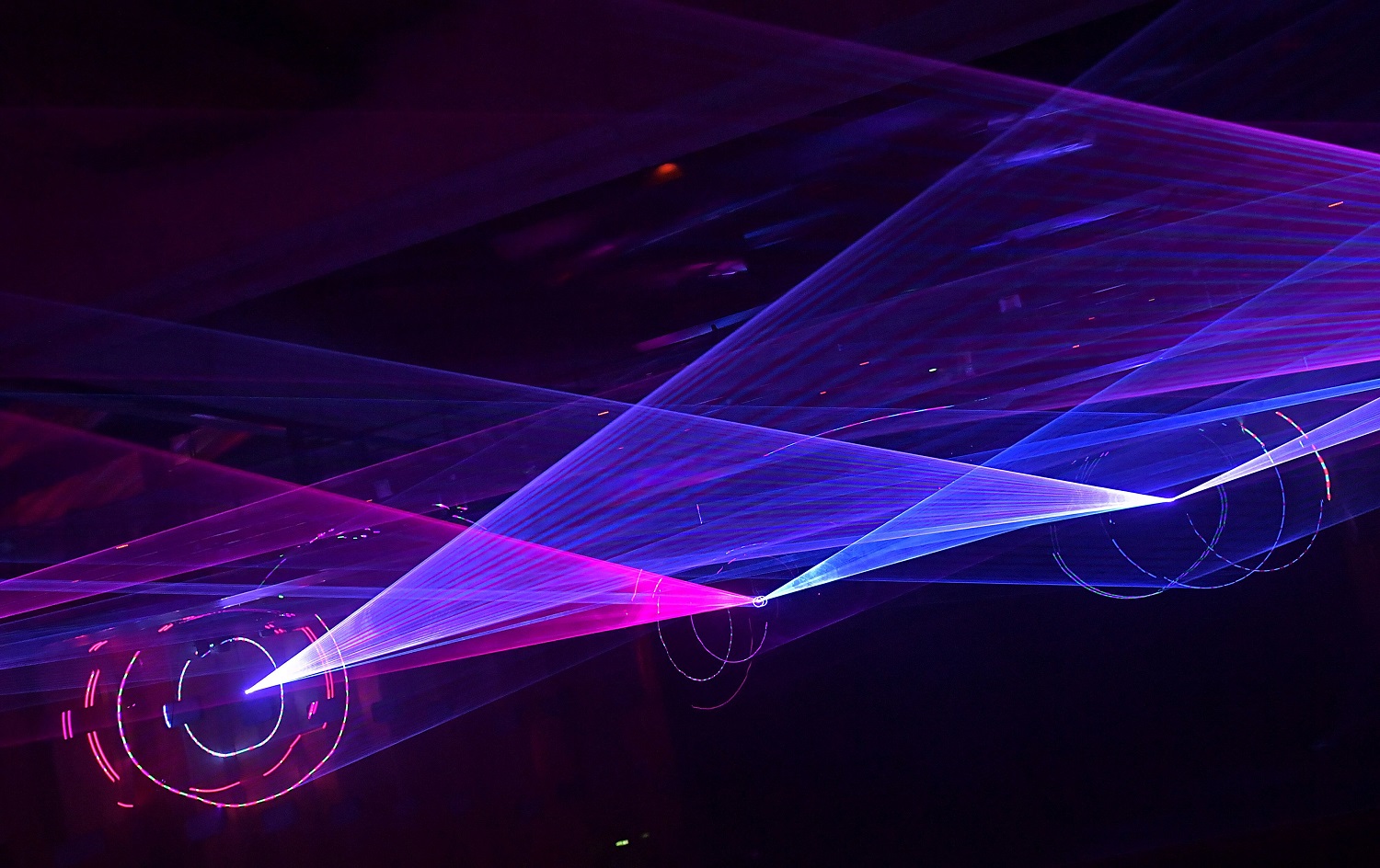Singcircle, Barbican review - veteran ensemble bids farewell with Stockhausen | reviews, news & interviews
Singcircle, Barbican review - veteran ensemble bids farewell with Stockhausen
Singcircle, Barbican review - veteran ensemble bids farewell with Stockhausen
Two-work memorial proves the composer still radical ten years after his death

STIMMUNG is always an event. Stockhausen’s score calls for a ritual as much as a performance, with six singers sitting around a spherical light on a low table, the audience voyeurs at some intimate but unexplained rite.
As with most of Stockhausen’s music, the concept behind STIMMUNG looks crazy on paper but is utterly convincing in performance. Most of the music is performed in overtone singing, similar to the Tibetan monastic tradition. Over this, Stockhausen adds a range of spoken and vocal effects: names of deities from different cultures, private jokes, and erotic poetry (this last perhaps explained by the fact it was written in America in 1967). The singers are all amplified, and the sounds projected around four speakers – the sound projection this evening led by Stockhausen’s amanuensis Kathinka Pasveer, assisted by composer Stephen Montague.
The resulting mix of vocal timbres added valuable richness and complexity
Atmosphere is the most important part of STIMMUNG, and Singcircle got that just right. Black drapes covered the wooden panelling of the Barbican Hall and, apart from the central, spherical light, all else was darkness. The composition of the ensemble seems to have changed a lot over the decades, and the list of previous members includes many luminaries, including Paul Hillier, who now regularly performs STIMMUNG with his own ensembles. The six singers for this performance were a curious mix of young and old, two of the singers seemingly as old as Rose, and two others recent graduates. The resulting mix of vocal timbres added valuable richness and complexity, especially as the textures are almost always based on unsynchronised lines between the voices. The older singers did struggle, however, and the pure sound of the ethereal overtone effects was often hard-won. Sensitive amplification helped, and the spirit of the work was never compromised.
The second half of the concert brought us up to date with COSMIC PULSES, Stockhausen’s final purely electronic work, completed in 2007, the year of his death. This is complex and imposing music, but its lineage from Stockhausen’s pioneering works of the 1950s and 60s is clear. Dull, bell-like sonorities, deep in the bass, introduce the more complex mid-range effects. And when the music begins to explore the upper registers, it is with whistling overtone series, skipping up and down the higher partials. But by this time, digital technology had changed the way Stockhausen worked, allowing him to create ever-more complex textures and spacialisation effects, this work written for an eight-speaker array. Stockhausen’s technical summary, faithfully reproduced in the programme, told us little about what he was hoping to express. Fortunately, the Barbican engaged a laser artist, Robert Henke, to provide a visual interpretation (pictured above). He set eight lasers around the upper space of the hall, to match the speaker array. Dry ice made all the laser beams visible, and each gradually opened out into a spinning cone of complex patterns as the music grew in intensity. Although as confrontational and complex as the music, Henke’s projections also managed to maintain the sense of abstract ritual that had been so perfectly captured in the performance of STIMMUNG. Even with Henke’s help, this was difficult music to take in, but it spoke of a truly unique composing voice, which still has much to tell us. Ten years after his death, Stockhausen’s music is still waiting for the rest of us to catch up.
Stockhausen’s technical summary, faithfully reproduced in the programme, told us little about what he was hoping to express. Fortunately, the Barbican engaged a laser artist, Robert Henke, to provide a visual interpretation (pictured above). He set eight lasers around the upper space of the hall, to match the speaker array. Dry ice made all the laser beams visible, and each gradually opened out into a spinning cone of complex patterns as the music grew in intensity. Although as confrontational and complex as the music, Henke’s projections also managed to maintain the sense of abstract ritual that had been so perfectly captured in the performance of STIMMUNG. Even with Henke’s help, this was difficult music to take in, but it spoke of a truly unique composing voice, which still has much to tell us. Ten years after his death, Stockhausen’s music is still waiting for the rest of us to catch up.
rating
Explore topics
Share this article
The future of Arts Journalism
You can stop theartsdesk.com closing!
We urgently need financing to survive. Our fundraising drive has thus far raised £49,000 but we need to reach £100,000 or we will be forced to close. Please contribute here: https://gofund.me/c3f6033d
And if you can forward this information to anyone who might assist, we’d be grateful.

Subscribe to theartsdesk.com
Thank you for continuing to read our work on theartsdesk.com. For unlimited access to every article in its entirety, including our archive of more than 15,000 pieces, we're asking for £5 per month or £40 per year. We feel it's a very good deal, and hope you do too.
To take a subscription now simply click here.
And if you're looking for that extra gift for a friend or family member, why not treat them to a theartsdesk.com gift subscription?
more Classical music
 Kempf, Brno Philharmonic, Davies, Bridgewater Hall, Manchester review - European tradition meets American jazz
Bouncing Czechs enjoy their Gershwin and Brubeck alongside Janáček and Dvořák
Kempf, Brno Philharmonic, Davies, Bridgewater Hall, Manchester review - European tradition meets American jazz
Bouncing Czechs enjoy their Gershwin and Brubeck alongside Janáček and Dvořák
 Solomon, OAE, Butt, QEH review - daft Biblical whitewashing with great choruses
Even a top soprano and mezzo can’t make this Handel paean wholly convincing
Solomon, OAE, Butt, QEH review - daft Biblical whitewashing with great choruses
Even a top soprano and mezzo can’t make this Handel paean wholly convincing
 Two-Piano Gala, Kings Place review - shining constellations
London Piano Festival curators and illustrious friends entertain and enlighten
Two-Piano Gala, Kings Place review - shining constellations
London Piano Festival curators and illustrious friends entertain and enlighten
 Echo Vocal Ensemble, Latto, Union Chapel review - eclectic choral programme garlanded with dance
Beautiful singing at the heart of an imaginative and stylistically varied concert
Echo Vocal Ensemble, Latto, Union Chapel review - eclectic choral programme garlanded with dance
Beautiful singing at the heart of an imaginative and stylistically varied concert
 Scott, Irish Baroque Orchestra, Whelan, RIAM, Dublin review - towards a Mozart masterpiece
Characteristic joy and enlightenment from this team, but a valveless horn brings problems
Scott, Irish Baroque Orchestra, Whelan, RIAM, Dublin review - towards a Mozart masterpiece
Characteristic joy and enlightenment from this team, but a valveless horn brings problems
 Classical CDs: Voice flutes, flugelhorns and froth
Baroque sonatas, English orchestral music and an emotionally-charged vocal recital
Classical CDs: Voice flutes, flugelhorns and froth
Baroque sonatas, English orchestral music and an emotionally-charged vocal recital
 Kanneh-Mason, Britten Sinfonia, Shave, Milton Court - a grin and a big beaming smile
A pair of striking contemporary pieces alongside two old favourites
Kanneh-Mason, Britten Sinfonia, Shave, Milton Court - a grin and a big beaming smile
A pair of striking contemporary pieces alongside two old favourites
 theartsdesk at the New Ross Piano Festival - Finghin Collins’ musical rainbow
From revelatory Bach played with astounding maturity by a 22 year old to four-hand jazz
theartsdesk at the New Ross Piano Festival - Finghin Collins’ musical rainbow
From revelatory Bach played with astounding maturity by a 22 year old to four-hand jazz
 First Person: Manchester Camerata's Head of Artistic Planning Clara Marshall Cawley on questioning the status quo
Five days of free events with all sorts of audiences around Manchester starts tomorrow
First Person: Manchester Camerata's Head of Artistic Planning Clara Marshall Cawley on questioning the status quo
Five days of free events with all sorts of audiences around Manchester starts tomorrow
 Goldscheider, Brother Tree Sound, Kings Place review - music of hope from a young composer
Unusual combination of horn, strings and electronics makes for some intriguing listening
Goldscheider, Brother Tree Sound, Kings Place review - music of hope from a young composer
Unusual combination of horn, strings and electronics makes for some intriguing listening

Add comment